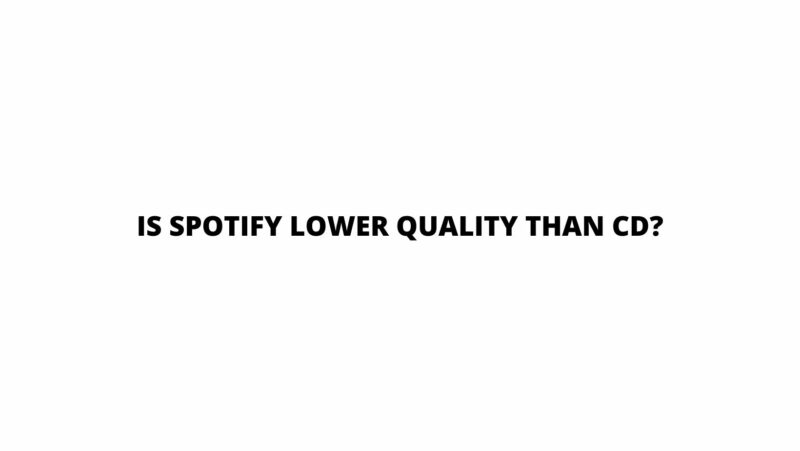In the digital age of music consumption, the battleground of audio quality has expanded to encompass the clash between the revered Compact Disc (CD) and the ubiquitous music streaming giant, Spotify. The question at the heart of this discourse is whether Spotify’s audio quality is genuinely lower than that of the CD. This article embarks on a thorough exploration of both sides of the debate, delving into the technical aspects of audio compression, the nuances of human perception, and the ever-evolving landscape of music consumption. By dissecting the attributes of CD and Spotify audio quality, we aim to shed light on the nuanced relationship between convenience and fidelity.
Understanding CD Audio Quality
Uncompressed Brilliance: CDs are celebrated for their uncompressed audio format. With a bit depth of 16 bits and a sample rate of 44.1 kHz, they meticulously capture the range of frequencies and nuances present in the original recording.
Authentic Representation: The lossless nature of CDs ensures that the audio is reproduced exactly as it was recorded. This fidelity appeals to audiophiles and purists who prioritize the unadulterated listening experience.
Advantages of CDs: Authenticity and Fidelity
- Dynamic Range: CDs offer a wide dynamic range, capturing the full spectrum of sound from the softest whisper to the loudest crescendo.
- Analog Warmth: CDs can evoke the warmth of analog recordings due to the nuances introduced during the analog-to-digital conversion.
Decoding Spotify Audio Quality
Audio Compression: Spotify employs audio compression techniques to reduce file sizes for efficient streaming. The Ogg Vorbis codec is commonly used to strike a balance between quality and data efficiency.
Bitrate Variations: Spotify offers different bitrate options, ranging from 24 kbps (for streaming in restricted network conditions) to 320 kbps (for Premium subscribers). Higher bitrates generally translate to better audio quality.
Lossy Compression: The compression used by Spotify is lossy, meaning that some audio data is discarded to achieve smaller file sizes. This can potentially lead to a compromise in audio quality.
Perceived Differences: Audiophiles vs. Casual Listeners
Audiophile Perspective: Audiophiles, who prioritize audio quality and often invest in high-end audio equipment, tend to assert that the quality of Spotify’s audio is noticeably lower than that of CDs. They often emphasize the richness, depth, and authenticity of CD audio.
Casual Listener Perspective: Casual listeners might not discern the subtle differences between CD and Spotify audio quality, especially in everyday listening scenarios. For them, the convenience and vast library offered by Spotify outweigh the minor perceptual discrepancies.
The Role of Human Perception
The Psychoacoustic Phenomenon: Human perception of audio quality is influenced by psychoacoustic principles. Our ears and brain process audio in complex ways, sometimes masking minor imperfections.
Perceptual Coding: Spotify’s compression techniques leverage perceptual coding to remove audio data that the human ear is less sensitive to. This allows for efficient file sizes without significantly compromising perceived quality.
Listening Conditions and Equipment: The quality of headphones or speakers and the listening environment play a pivotal role in the perceptibility of differences between CD and Spotify audio quality.
Comparative Listening Tests: Unveiling the Differences
Blind Tests: Blind listening tests, where participants are unaware of the source (CD or Spotify), are commonly conducted to assess perceptual differences. The results of these tests offer insights into whether listeners can reliably distinguish between the two.
The Complex Equation: Quality vs. Convenience
Quality Argument: From a technical standpoint, CD audio quality is superior due to its lossless nature and preservation of original sound. Audiophiles often contend that this level of authenticity is crucial for a complete musical experience.
Convenience Argument: Spotify offers unparalleled convenience, allowing users to access a vast library of music across devices. The convenience of streaming makes it the go-to choice for many in our fast-paced digital world.
Subjectivity and Choice
The ultimate verdict on whether Spotify’s audio quality is lower than CD quality is highly subjective. It depends on the individual’s priorities, the quality of their audio equipment, and their listening habits.
Conclusion: Harmonizing Convenience and Quality
The debate over whether Spotify’s audio quality is lower than that of CDs transcends mere technical specifications. It intersects with the complex interplay between technology, human perception, and individual preferences.
While CDs undoubtedly offer superior audio fidelity due to their uncompressed format, the convenience and accessibility of Spotify have transformed how we consume music. For some, the perceptible differences between the two formats are paramount, while for others, the minor compromises in audio quality are a small price to pay for the convenience and versatility of streaming.
In this ever-evolving landscape of music consumption, the choice between CD and Spotify audio quality is a personal one, marked by the harmonious blend of quality and convenience that suits each individual’s unique auditory journey.


